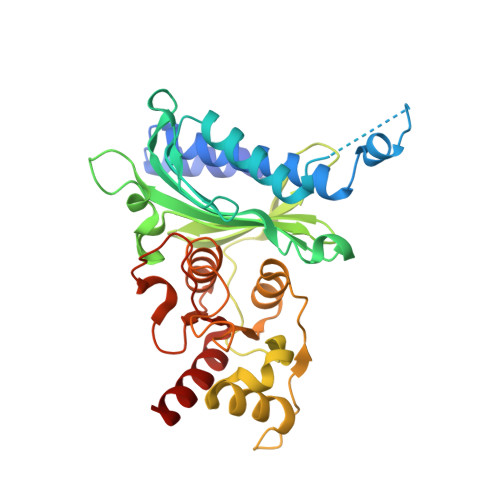ANILINOQUINAZOLINE INHIBITORS OF FRUCTOSE 1,6-BISPHOSPHATASE BIND AT A NOVEL ALLOSTERIC SITE: SYNTHESIS, IN VITRO CHARACTERIZATION, AND X-RAY CRYSTALLOGRAPHY
Wright, S.W., Carlo, A.A., Carty, M.D., Danley, D.E., Hageman, D.L., Karam, G.A., Levy, C.B., Mansour, M.N., Mathiowetz, A.M., McClure, L.D., Nestor, N.B., McPherson, R.K., Pandit, J., Pustilnik, L.R., Schulte, G.K., Soeller, W.C., Treadway, J.L., Wang, I.-K., Bauer, P.H.(2002) J Med Chem 45: 3865-3877
- PubMed: 12190310
- DOI: https://doi.org/10.1021/jm010496a
- Primary Citation of Related Structures:
1KZ8 - PubMed Abstract:
The synthesis and in vitro structure-activity relationships (SAR) of a novel series of anilinoquinazolines as allosteric inhibitors of fructose-1,6-bisphosphatase (F16Bpase) are reported. The compounds have a different SAR as inhibitors of F16Bpase than anilinoquinazolines previously reported. Selective inhibition of F16Bpase can be attained through the addition of appropriate polar functional groups at the quinazoline 2-position, thus separating the F16Bpase inhibitory activity from the epidermal growth factor receptor tyrosine kinase inhibitory activity previously observed with similar structures. The compounds have been found to bind at a symmetry-repeated novel allosteric site at the subunit interface of the enzyme. Inhibition is brought about by binding to a loop comprised of residues 52-72, preventing the necessary participation of these residues in the assembly of the catalytic site. Mutagenesis studies have identified the key amino acid residues in the loop that are required for inhibitor recognition and binding.
Organizational Affiliation:
Pfizer Central Research, Eastern Point Road, Groton, Connecticut 06340, USA. [email protected]


















